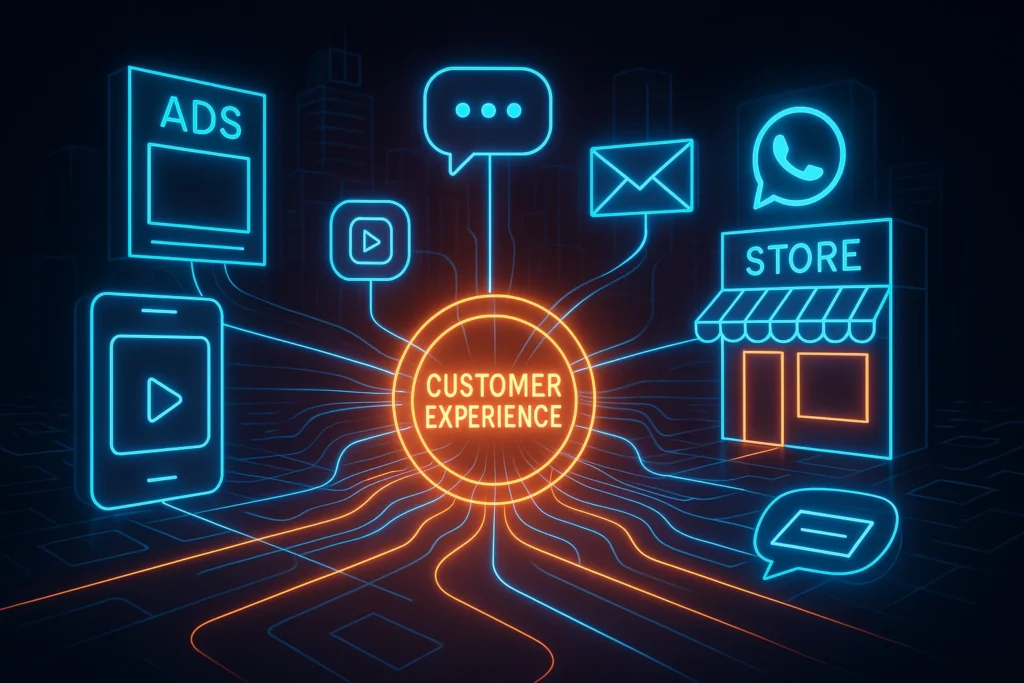Today’s hyper connected world has shifted consumers’ expectations. They want great products, but they want more than just products. They want seamless experiences. They want personalized and consistent experiences whether they are browsing the web, entering a storefront, scrolling through Instagram, or chatting with a brand through WhatsApp.
That’s where omnichannel marketing comes into play. Omnichannel is no longer just a buzzword; it is the future of effective branding.
Meaning of Omnichannel Marketing :
Omnichannel marketing is a strategy for the seamless, integrated use of your various marketing channels both online and offline to bring together a cohesive brand experience for the consumer. Omnichannel is distinct from multichannel marketing; multichannel marketing can simply mean that you are putting your marketing message out to as many channels as you can, with eac…
To illustrate: a consumer adds a product to their cart on the website, gets a reminder on Instagram, an email with a discount and completes the purchase via your mobile application. In that example, you can see the potential for omnichannel tracking!
Why Today’s Consumers Want Omnichannel Experiences ?
Consumer behavior has changed substantially:
• 73% of shoppers utilize multiple channels at some point in their buying journey.
• Consumers routinely switch the device (phone, desktop, tablet) or platform (Instagram, email, in-store) they are using when deciding to purchase.
• They no longer want transactional messaging and want curated communications instead.
The brands that understand this change and can pivot are the ones capturing the hearts and wallets of consumers.
Advantages of Omnichannel Marketing :
1. Better Customer Experience
Omnichannel gives customers what they want convenience, consistency, and control. Customers stay engaged and loyal when they don’t have to start over from square one every time they switch platforms.
2. More Engagement
Customers feel more connected when messaging is consistent throughout all platforms. With a consistent voice across any touchpoint, be it Instagram Stories or a support chatbot, you can develop more meaningful relationships.
3. More Data Insights
Omnichannel sells provide a 360-degree view of your customer what they like, how they act, when they are buying – which can help you develop better campaigns to improve conversions.
4. Increased Revenue
Companies that have strong omnichannel strategies retain 91% more year-over-year than those without one and spend 3x more than other consumers according to research.
Omnichannel in Practice: Live Examples
• Nike: Utilizes the app, store, web and social channels as a single merged marketplace. Customers can search for items online and access in-store inventory, receive location-based offers and access rewards across channels.
• Starbucks: Orders through the app, still tracks locations via an app, and the rewards system works across mobile, desktop, and physical stores.
• Zomato and Swiggy: Push notifications and email offers, loyalty programs, embedded into the app’s suggestions.
These brands do much more than sell; they create a buying experience.
Fundamental Elements of Omnichannel Approach :
One Customer Data Platform (CDP): Consolidates customer data to be able to provide personalized marketing.
Consistent Branding, Tone, and Message: Consistently, across platforms, be consistent in their tone, style, values, etc.
Real-Time Interactivity/Engagement: Making use of automation and AI to engage the customer in real-time and contextualized manner.
Azimuths of Omnichannel Marketing :
The best omnichannel strategies will not rely on one specific channel. Instead, they utilize a combination of online and offline channels. These channels can include email marketing, website, mobile app, SMS/WhatsApp campaigns, social media outlets like Instagram and Facebook, in-store experiences, customer service (live chat or call centre), and even push notifications. Here, we are not only talking about utilising different channels, but combining those channels into an integrated interaction and interconnected relevance.
How to Establish Omnichannel Marketing ?
1. Map the Experience
Understand how and where your audience touches your brand from the moment of discovery and even afterwards. Then, identify every possible touchpoint that allows you to create a seamless experience.
2. Connect Your Data
Research and find a combination of tool(s) such as CRM systems & customer data platforms that allow you to aggregate and connect data from all of your channels.
3. Personalize
Take advantage of AI and behavioral insights to deliver curated product recommendations, dynamic emails or push notifications based on location.
4. Invest in the right tools
Think about including tools like:
• HubSpot (for CRM + marketing automation)
• Klaviyo (for omnichannel email/SMS)
• Shopify + Meta + WhatsApp integrations
5. Train your team
Your marketing, sales and support team have to work together, in unison. Your ultimate objective should be to deliver a unified customer experience, not in isolation of each others KPIs.
Common Pitfalls :
• Using a single message on every platform without considering context
• Running email, SMS, and social campaigns without data being shared
• Ignoring feedback loops from customers cross-channel
• Over automation to the point of losing the human factor
Bottom line: omnichannel deviance ≠ being everywhere all at once. It is not just about being present, but relevance + consistency.
The Future Is Omnichannel. Are You Prepared?
As the digital and physical worlds continue to converge, customers expect brands to meet them where they are — and how they prefer.
Omnichannel marketing isn’t just about selling products or services. It’s a way of creating trust, loyalty, and relationship longevity through intentional and personalized interactions.
In a world with endless options, the brands that connect experiences will rise above the rest.
In conclusion :
Omnichannel isn’t the future — it’s already present. If you aren’t leveraging it, your brand is already lagging behind.
